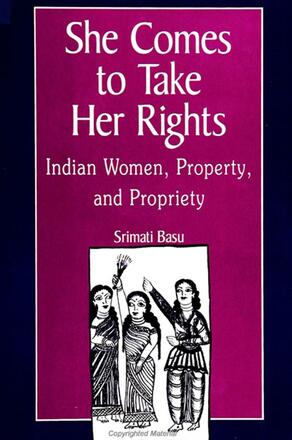
She Comes to Take Her Rights
Indian Women, Property, and Propriety
Alternative formats available from:
Examines the contemporary workings of property law in India through the lives and thoughts of middle-class and poor women.
Description
Using the contemporary workings of property law in India through the lives and thoughts of middle-class and poor women, this is a study of the ways in which cultural practices, and particularly notions of gender ideology, guide the workings of law. It urges a close reading of decisions by women that appear to be contrary to material interests and that reinforce patriarchal ideologies.
Hailed as a radical moment for gender equality, the Hindu Succession Act was passed in India in 1956 theoretically giving Hindu women the right to equal inheritance of their parents' self-acquired property. However, in the years since the act's existence, its provisions have scarcely been utilized. Using interview data drawn from middle-class and poor neighborhoods in Delhi, this book explores the complexity of women's decisions with regard to family property in this context. The book shows that it is not passivity, ignorance of the law, naiveté about wealth, or unthinking adherence to gender prescriptions that guides women's decisions, but rather an intricate negotiation of kinship and an optimization of socioeconomic and emotional needs. An examination of recent legal cases also reveals that the formal legal realm can be hospitable to women's rights-based claims, but judgments are still coded in terms of customary provisions despite legal criteria to the contrary.
Srimati Basu is Assistant Professor of Anthropology at Depauw University.
Reviews
"Basu's research offers a persuasive argument that it is not passivity or ignorance that restricts women's enjoyment of property ownership, but a conscious negotiation of familial relationships and bonds to build social capital and ensure immediate and long–term emotional and material security. " — Feminist Collections
"Our view of India is filled with images of downtrodden women in various guises: women burned to death over dowry, women immolated on their husbands' funeral pyres, women committing female infanticide, women who are poor, illiterate, exploited. In Western discourse about India, Indian women are constructed as helpless victims and in the process Indian society and culture is constituted as less than modern. We need to understand the lives of Indian women because the repetition of the atrocity stories tell us very little about what is happening, why it is happening, and what is changing or likely to change. Basu's decision to focus on women and property and ask the 'why' question makes this a very important book. " — Geraldine Forbes, State University of New York, Oswego